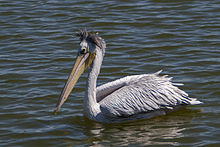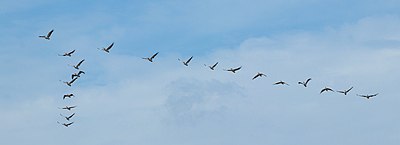Red pelican
| Red pelican | ||||||||
|---|---|---|---|---|---|---|---|---|

Red pelican ( Pelecanus rufescens ) |
||||||||
| Systematics | ||||||||
|
||||||||
| Scientific name | ||||||||
| Pelecanus rufescens | ||||||||
| Gmelin , 1789 |
The Pink-backed Pelican ( Pelecanus rufescens ) is a species of bird from the family of pelicans and the smallest Pelikanart the Old World . Its distribution extends over tropical and subtropical Africa to southern Egypt and the western edge of the Arabian Peninsula . In contrast to the two large pelican species, the pink and Dalmatian pelican, it does not breed on the ground, but on trees. The colonies are usually much smaller with 20 to 500 pairs.
description
With a length of 125 to 132 cm and a wingspan between 216 and 290 cm, the red chalk pelican is the smallest pelican species in the Old World . The beak length is 29 to 38 cm. The sexes do not differ in appearance. But females are much smaller.
A narrow area of skin around the eye is not feathered and in adult birds in breeding plumage it is yellow-orange to orange-pink, in the lower part it is rather light yellow. The eye is bordered by a narrow strip at the back and wider at the front of the reins by dark slate-gray skin. The area above the eye can also be bordered whitish and completely dark. Outside the breeding season, the bare skin around the eye is whitish and the dark areas are paler or reduced to a small spot in front of the eye. The iris is very dark brown. The beak is straw yellow to pale pink and sometimes shows some dark spots at the base. The nail is usually orange, the throat pouch yellow with dark, oblique and parallel lines or salmon red with densely arranged whitish lines. Legs and feet are flesh-colored to pale orange, or light pink to pink-red during the breeding season.
During the breeding season, adult birds have a shaggy, predominantly gray feather bonnet. The plumage is white with interspersed gray. The individual feathers are long and pointed and those on the upper side of the body show a blackish shaft line. The plumage on the goiter and front breast is yellowish to pale pink. There is also a pale pink color on the flanks and back, which turns greyish towards the rump and the upper tail- coverts. The upper wing coverts are whitish like the body plumage, the outer large arm coverts show dark gray feather centers. The covers of the hands and the wings of the thumb are gray to blackish. The wings of the hand are completely blackish, the wings of the arm and umbrella feathers have blackish centers and a diffuse, silvery-gray border on the outer flag that is increasingly wide towards the base of the wing. The underside of the wings are gray with an increasingly dark tip and white shaft line. The large forearm covers form a white band that separates from the wings and the pale pink rest of the lower wing, including the axillary feathers. The control feathers are whitish with dark shafts and can be tinted slightly gray.
Outside of the breeding season, the plumage is overall grayer and the bonnet is much shorter. The bare skin areas are less intensely colored and the pink coloring on the sides and top is less noticeable.
Young birds resemble adult animals, but have shorter, not elongated, pointed feathers. The top of the head and neck are gray-brown. The upper back, shoulder feathers and upper wings are gray-brown with light feather edges, while the lower back, rump and upper tail-coverts are whiter. The wings are browner than in adult birds, the underside of the body is more uniformly whitish. The featherless parts resemble those of adult birds outside the breeding season. However, the legs, feet and beak are often rather grayish. The nail of the beak is more yellow.
Red pelican egg in the Museum of Toulouse
voice
As with other pelicans, various guttural vocalizations can be heard in the colonies of the red chalk pelican. Outside the colonies, the species is mostly silent.
distribution
The red chalk pelican inhabits parts of tropical and subtropical Africa and occurs here mainly in the savannah area. It is largely absent in the arid regions and in the rainforest belt. The distribution extends from Senegal eastwards to Sudan and Somalia . The species is also found in small numbers in southeastern Egypt and colonizes the southwest of the Arabian Peninsula. In the south the area extends to Namibia and northern South Africa .
In France there is a wild red pelican population in the Réserve Africaine in Sigean near Narbonne . The birds also regularly move within a 10 km radius of the park.
hikes
The red pelican is believed to be a partial migrant , with local migratory movements being strongly related to rainy and dry seasons and patterns being difficult to see due to the inconsistent breeding seasons. Apparently, however, many birds regularly migrate to the savannah areas south of the Sahara during the rainy season. Young birds in particular have a tendency to dismigrate .
As a rare guest bird, the great white pelican still appears fairly regularly in North Aegyten and Israel, and more rarely in Jordan and Turkey. Since the 1980s, the species has also increasingly appeared in Europe as a random visitor. Some of the birds are believed to be captive refugees or birds from the colony in southern France. However, on closer examination of the evidence, significant patterns were found, which indicate that a greater part of the incidence of African wild birds could well be involved. For example, an accumulation of records in Italy, Andalusia and Corsica in 2001 correlated with exceptional rainfall in the Sahel zone, and overall a correlation with summer rain in the Sahel zone, rainy years in Kenya or good breeding successes in the Middle East can be demonstrated.
habitat
The habitat requirements of the red pelican are quite variable. It is preferred on freshwater lakes, in swamps, on rivers and floodplains, occasionally on bays on the seashore or on soda lakes . It can also be found in dry habitats if there is a good food supply for grasshoppers .
The species breeds on trees that are on banks, on sandy islands, in mangrove forests or sometimes even in the cultivated landscape. The birds' droppings can cause the trees to die after several successive breeding seasons.
Outside of the breeding season, the species can also be found resting on rocks, coral reefs, sand dunes, quays and harbor walls. In contrast to other pelican species, it tends to tolerate closeness to humans.
nutrition
The red pelican feeds on fish, the weight of which can be up to 400 g, but mostly between 80 and 290 g. As with the African population of the Great White Pelicans, cichlids , especially of the genus Haplochromis, are preferred . The species also feeds a lot on fish spawn. In contrast to the Great White Pelican, the species mostly fishes alone and not in a group. With the head held high, they swim and look for prey. If a fish can be seen, the pelican retracts its neck, approaches the fish and then strikes. The daily requirement is around 776 g and is therefore smaller than that of the large pelican species.
Reproduction
Red chalk pelicans reach sexual maturity after three to four years. Breeding can take place all year round. They are usually started at the end of a rainy season. In the northern breeding areas on the Red Sea , the breeding season is between October and February, but a little further south it can extend into July.
The species breeds on trees. Colonies are usually smaller than the large pelican species. The number of pairs is usually between 20 and 500 pairs. The very small nest consists of sticks. The clutch usually comprises two, rarely one to three eggs, which are incubated for about a month. The nestling period lasts about 84 days. Later the boys will be looked after by their parents for about 21 days.
The breeding success can be very different, but is usually less than one surviving young per brood. A common cause of nestling mortality is sibling rivalry.
Existence and endangerment
The red pelican is widespread and usually not rare. The IUCN therefore regards it as not threatened worldwide ( least concern ). It can be local, such as in the sub-Saharan regions. However, an assessment of the total population is difficult because the rather small colonies are scattered and can change locations quickly.
In Saudi Arabia , the population was estimated at 1200 to 1500 copies in the 1990s, and at 500 in Yemen. At the beginning of the millennium, 235 breeding pairs were breeding on the islands off Eritrea . The population in Senegal and Guinea-Bissau is estimated at 4200 to 6200 individuals (1982), in Nigeria the population has declined sharply in recent decades. In South Africa the population numbers are rather small and fluctuate strongly. In Madagascar, the species became extinct before the 1960s, as the only colony was probably destroyed by residents. Since then there have only been rare individual observations there.
The main sources of danger are the destruction of habitats through drainage and the increasing cultivation of wetlands with accompanying disturbances to the colonies. Since the species is less shy than the Great White Pelicans, the impact of disturbances at the breeding site is less. It is also likely to be less perceived as a fishery pest. Nevertheless, local colonies and nesting trees can also be destroyed. Increasing pollution and the accumulation of harmful substances in body tissue can also affect the species.
Web links
- Pelecanus rufescens in the endangered Red List species the IUCN 2008. Posted by: BirdLife International, 2008. Accessed January 31 of 2009.
- Videos, photos and sound recordings of Pelecanus rufescens in the Internet Bird Collection
- Red pelican feathers
literature
- Andrew Elliott, David A. Christie , Francesc Jutglar, Arnau Bonan, Ernest FJ Garcia, Guy M. Kirwan : Pink-backed (Peleacanus rufescens) . (1992/2016), in: J. del Hoyo, A. Elliott, J. Sargatal, AD Christie, E. de Juana (eds.): Handbook of the Birds of the World Alive. Lynx Edicions, Barcelona 2016.
Individual evidence
- ↑ a b c d e Elliot et al. (2016), section “Descriptive Notes”, see literature
- ↑ Elliot et al. (2016), section “Voice”, see literature
- ↑ Elliot et al. (2016), section “Taxonomy - Distribution”, see literature
- ↑ a b F. Jiguet, A. Doxa, A. Robert: The origin of out-of-range pelicans in Europe: wild bird dispersal or zoo escapes? , Ibis, Volume 150, Issue 3, July 2008, pp. 606-618, doi : 10.1111 / j.1474-919X.2008.00830.x
- ↑ a b Elliot et al. (2016), section “Movements”, see literature
- ↑ Hans-Günther Bauer, Einhard Bezzel, Wolfgang Fiedler (eds.): The Compendium of Birds in Central Europe , Aula-Verlag, Wiebelsheim 2012, ISBN 978-3-89104-758-3 , p. 230 f
- ↑ a b c Elliot et al. (2016), section “Habitat”, see literature
- ↑ Elliot et al. (2016), section “Food and feeding”, see literature
- ↑ Andrew Elliot, Arnau Bonan: Pelicans (2016), section Food and feeding , in: J. del Hoyo, A. Elliott, J. Sargatal, AD Christie, E. de Juana (eds.): Handbook of the Birds of the World Alive. Lynx Edicions, Barcelona 2016
- ↑ a b c Elliot et al. (2016), section “Breeding”, see literature
- ↑ a b c Elliot et al. (2016), section “Status and conservation”, see literature













